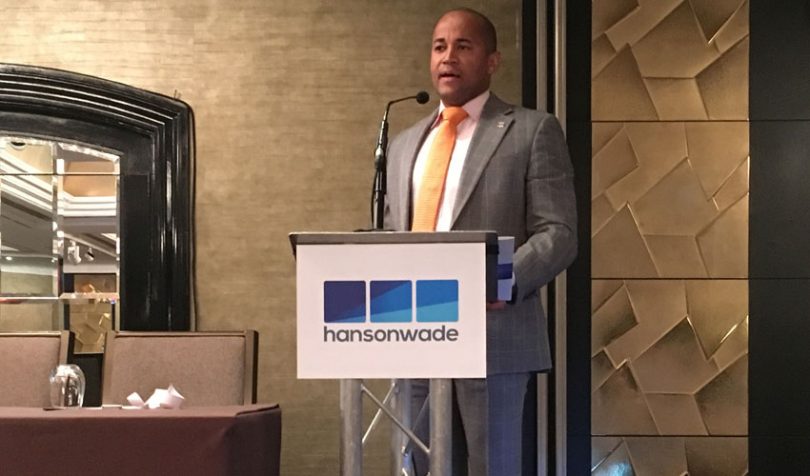At last week’s Blockchain in Insurance Summit, there were contrasting views about the potential for blockchain. The majority of incumbents focus on the efficiencies that blockchain digitization can bring. Others see this as ignoring the transformational potential of the technology. One compared insurance to being “print media and the internet just showed up.”
Dante Disparte, CEO of Risk Cooperative didn’t pull his punches. “If there’s one takeaway I have from the conversations over the last few days it’s that the technology gap isn’t the biggest gap or the biggest chasm to cross. It’s the cross arm leadership culture that has ossified in the insurance industry, where status quo is safe. And breaking from status quo is ultimately what a lot of this digital transformation is all about.”
For each group of players, there are efficiency opportunities, revenue opportunities, and existential threats. Much depends on the particular situation.
Brokers
One view is with blockchain automation, brokers become redundant. The flipside is they own the client relationships.
Disparte, as a broker, sees it the latter way. “The distribution and the client access, so Willis (Towers Watson) and my firm are better defended today. We have a better moat around our company than the balance sheets do.”
It also depends on how commoditized the insurance is.
Willis is Maersk’s broker and participated in the InsurWave blockchain launched this month. It’s speculation, but not a stretch to expect that Willis had to reduce their commission rate for blockchain transactions.
Right now for Willis that is likely more of an opportunity than a threat. Maersk plans to roll out blockchain insurance to cargo clients, from start-to-end in the supply chain. So Willis could get a bigger slice of the pie.
However, the average commission for marine insurance brokers as a whole will decline.
Roll forward a year or three, and it’s also not hard to imagine Maersk might want to renegotiate the Willis deal.
Insurers
Oliver Volk, from Allianz Re and B3i last month articulated the industry view. “At the very beginning when blockchain came up, there was the threat that everything between the policyholder and the capital market will be done with the help of blockchain.”
“So there will be the policyholder and some automation in between and then the capital market,” said Volk. “That threat is not that big anymore, because reality has shown it’s very complicated.”
Stephan Karpischek of Etherisc outlined his organization’s creation. He showed a diagram of a smart contract for flight delay insurance. The founder explained the potential for a Decentralized Autonomous Organisation. “What is the interesting thing about this slide?” he asked. “Where is the insurance company? Do you still need an insurance company? We need an insurance company for one single reason. To call this insurance.”
At the same time, he acknowledged it wouldn’t happen tomorrow.
“I think there’s a much more important question than asking ‘what can blockchain do for OUR business model?’ You need to ask yourself: Where will the ball be in 10 or 20 years?”
As a broker, Disparte views insurers primarily as a source of capital. “The balance sheet is fungible. And so part of how we’ve gone to market and getting big insurers across the finish line is to put them on notice. The products are starting to look a lot like vanilla and the differentiation is now emerging from the intermediary.”
Some incumbents are very capable of innovating. A good example is MetLife’s parametric insurance for pregnant mothers. Zia Zaman, Chief Innovation Officer for MetLife in Asia, uses the term Micro-Moment insurance: life events for which we need protection, and which weren’t viable without automation.
Reinsurers
Reinsurers are probably the players with the least existential threat. This perhaps was behind SoftBank’s (now defunct) talks about buying a stake in Swiss Re.
Reinsurers can gain from efficiencies. Plus greater automation and squeezing of carriers are likely to push a bigger slice of insurance downstream to reinsurers.
When the Etherisc scenario takes off, you might have fully automated blockchain insurance, possibly with a reinsurer.
However, there are threats.
Allianz Re’s Volk acknowledged the flux: “We’re trying to optimize the processes step by step rather than disrupting the whole system, the whole value chain. But sooner or later there will be major changes affecting the whole value chain.”
Unrelated to insurance, in recent months there’s been activity around tokenized securities (ICOs) which are legally compliant. Tokenized securities are well suited to markets which are relatively illiquid. Like Insurance Linked Securities (ILS).
In the past reinsurers had too high a volume of catastrophe insurance on their books. To reduce their risk exposure, they sold off some of the risks in the form of Catastrophe Bonds. That’s how ILS started.
Last year Solidium issued a Catastrophe Bond on a private blockchain.
According to AON Benfield, reinsurer traditional capital is around $518bn, up 61 percent since 2008. ILS and Collateralized Insurance are $82bn, an increase of more than 400 percent since the financial crisis. Cryptocurrencies are capitalized at $305bn, quadrupling in the last twelve months, even after the downturn.
Nowadays ILS is pretty specialized both concerning the investors and the class of risk – primarily catastrophe risk. It might take a while, but the ICO landscape has the potential to open up both the pool of investors and broaden the classes of risk.
Consider something like InsurWave and the Maersk project with the availability of real-time reporting of claims. If one securitized the retrocession or reinsurance, that would work well for real-time pricing.
Society
Microinsurance in Asia is already massive and still offers significant growth opportunities. Companies like Galileo platforms aim to put the entire policy administration framework on a blockchain. Their target is mainstream insurers looking to enter under-served Asian markets. Think simple life insurance for $20 a year.
Until now, in Western developed countries microinsurance has not appealed because it’s seen as low margin. Not only can digitization make these policies viable, but these are fertile areas to experiment with blockchain. By targeting the protection gap, there’s no risk of cannibalizing existing revenues while getting familiar with the technology.
So far most microinsurance in Europe and the US are offered by startups and are internet economy based: delivery driver insurance, short-term car hire insurance and the like. The hope is that could spread to unprotected catastrophe risks.
Automation also throws up much more data. Big data allows for granular pricing. Unfortunately this ‘price discrimination’ is not good for society. Those most in need of cover could get priced out of the market. Which is an invitation to regulators.
Conclusion
Allianz Re’s Oliver Volk sums up incumbent perspectives: focus on optimizing processes. Significant change is on the horizon but not too soon.
Is the implication that waiting is ok?
ACORD’s Bill Pieroni thinks insurers can’t wait. So does Disparte: “I don’t think you have three to five years to figure this stuff out. If the adoption curve that Bill talked about this morning is any guide, this is like us being print media, and the internet just showed up.”
“And I really think the capital formation that is the current trench we build around our castles, that is not sufficient protection. Who has the lowest cost of capital? It’s a race to the bottom. With this technology, there is no fast second.”






